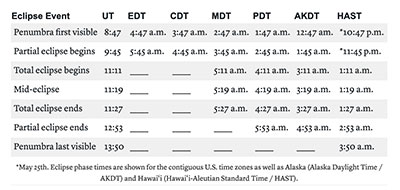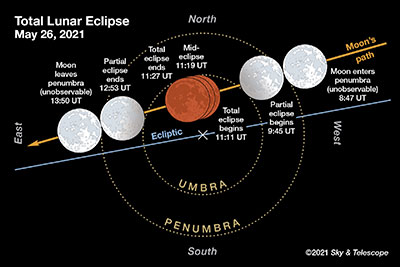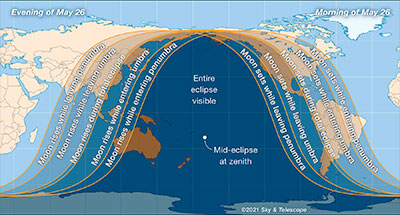Everything You Need to Know for the May 26th Morning Lunar EclipseThe total lunar eclipse of May 26th — the first in more than two years — favors western North America, but much of the continent will see the partial phases, provided skies are clear.
No one has seen a total lunar eclipse since January 20–21, 2019, but the drought is finally ending. Viewers in the western half of North America, western South America, East Asia, and Australia will see the Moon darken and turn a reddish hue on the morning of May 26th. Much of North America will see at least some of the penumbral stages, in which the Moon appears shadowed but not fully eclipsed. But the Moon will be low in the sky — for any chance of catching a glimpse of the event you'll need to find an open view to the southwest.
For the eastern U.S. and Canada, the Moon sets (and the Sun rises) as the early stages of the eclipse get underway. Midwesterners are luckier and might catch a peek of the setting Moon with about half of its disk immersed in Earth's dark, inner shadow. The western part of the continent will see the full eclipse, but you'll have to get up early (or stay up really, really late). For those in Hawai'i, you'll be in for a treat if your skies are clear: You'll get to witness the whole event, from start to finish.
Australia and East Asia should also get good views of the eclipse, since the Moon rises as the early stages of the eclipse get underway.
See the table and diagrams below for times of key events during May 26th's eclipse. The stages of the eclipse occur simultaneously for everyone who can see the Moon, but the actual clock times depend on your time zone:

"If you miss this eclipse, don't despair — the night of November 18–19 presents another lunar eclipse," says Diana Hannikainen (pronounced HUHN-ih-KY-nen), observing editor at Sky & Telescope. "Technically, the November event will be partial, but only the thinnest sliver of the Moon's disk will remain outside the umbra, so for all intents and purposes it'll be very much like a total eclipse."
What to Look For
Totality is predicted to last for 15 minutes and 52 seconds, so it's short as far as lunar eclipses go. Mid-eclipse May 26th (11:19 Universal Time) happens a mere 9½ hours after the Moon reaches perigee, the point in its orbit when it's closest to Earth. The Moon will appear around 8% larger than it does when it's at apogee (farthest from Earth in its orbit), but likely only dedicated Moon watchers will notice this.

A lunar eclipse happens when the Sun, Earth, and a full Moon form a near-perfect lineup in space, in what is known as syzygy. The Moon gradually glides into Earth's shadow, until the entire lunar disk turns from silvery grey to an eerie dim orange or red. Then events unfold in reverse order, until the Moon returns to full brilliance. The whole process for the May 26th eclipse will take a touch more than five hours.
"You only need your eyes to see the drama unfold, but if you have binoculars or a backyard telescope, they'll give a much-enhanced view," says Hannikainen.

The events that happen during a total lunar eclipse are more complex and interesting than many people realize. The event has five stages, each with different things to watch.
- The Moon's leading edge enters the pale outer fringe of Earth's shadow: the penumbra. You probably won't notice anything until the Moon is about halfway across the penumbra.
Watch for a slight darkening on the Moon's lower-left side as seen from North America. The penumbral shading becomes stronger as the Moon moves deeper in.
The penumbra is the region where an astronaut standing on the Moon would see Earth covering only part of the Sun's face.
- The Moon's leading edge enters the umbra, the cone of Earth's shadow within which the Sun's completely hidden. You should notice a dramatic darkening on the leading edge of the lunar disk. With a telescope, you can watch the edge of the umbra slowly engulfing one lunar feature after another, as the entire sky begins to grow darker.
- The trailing edge of the Moon slips into the umbra for the beginning of total eclipse. But the Moon won't black out completely: it's sure to glow some shade of intense orange or red.
Why is this? The Earth's atmosphere scatters and bends (refracts) sunlight that skims its edges, diverting some of it onto the eclipsed Moon. It's the same effect that happens at sunset. If you were on the Moon during a lunar eclipse, you'd see the Sun hidden by a dark Earth rimmed with the reddish light of all the sunrises and sunsets ringing the world at that moment.
The red umbral glow can be quite different from one eclipse to the next. Two main factors affect its brightness and hue. The first is simply how deeply the Moon goes into the umbra as it passes through; the center of the umbra is darker than its edges. The other factor is the state of Earth's atmosphere. If a major volcanic eruption has recently polluted the stratosphere with thin global haze, a lunar eclipse can be dark red, ashen brown, or occasionally almost black.
In addition, blue light is refracted through Earth's clear, ozone-rich upper atmosphere above the thicker layers that produce the red sunrise-sunset colors. This ozone-blue light tints the Moon also, especially near the umbra's edge. You'll need binoculars or a telescope to see this effect.
- As the Moon continues moving along its orbit, events replay in reverse order. The Moon's edge re-emerges into sunlight, ending totality and beginning a partial eclipse again.
- When all of the Moon escapes the umbra, only the last, penumbral shading is left. Some time later, nothing unusual remains.














